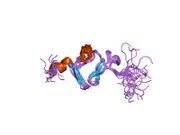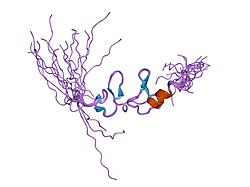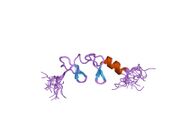Biology:LIMS1
 Generic protein structure example |
LIM and senescent cell antigen-like-containing domain protein 1 is a protein that in humans is encoded by the LIMS1 gene.[1][2][3]
Function
The protein encoded by this gene is an adaptor protein which contains five LIM domains, or double zinc fingers. The protein is likely involved in integrin signaling through its LIM domain-mediated interaction with integrin-linked kinase, found in focal adhesion plaques. It is also thought to act as a bridge linking integrin-linked kinase to NCK adaptor protein 2, which is involved in growth factor receptor kinase signaling pathways. Its localization to the periphery of spreading cells also suggests that this protein may play a role in integrin-mediated cell adhesion or spreading.[3]
Interactions
LIMS1 has been shown to interact with Integrin-linked kinase[2][4] and NCK2.[2][5]
References
- ↑ "A new LIM protein containing an autoepitope homologous to "senescent cell antigen"". Biochem. Biophys. Res. Commun. 201 (3): 1124–31. Aug 1994. doi:10.1006/bbrc.1994.1822. PMID 7517666.
- ↑ 2.0 2.1 2.2 "The LIM-only protein PINCH directly interacts with integrin-linked kinase and is recruited to integrin-rich sites in spreading cells". Mol. Cell. Biol. 19 (3): 2425–34. Mar 1999. doi:10.1128/mcb.19.3.2425. PMID 10022929.
- ↑ 3.0 3.1 "Entrez Gene: LIMS1 LIM and senescent cell antigen-like domains 1". https://www.ncbi.nlm.nih.gov/sites/entrez?Db=gene&Cmd=ShowDetailView&TermToSearch=3987.
- ↑ "Characterization of PINCH-2, a new focal adhesion protein that regulates the PINCH-1-ILK interaction, cell spreading, and migration". J. Biol. Chem. 277 (41): 38328–38. Oct 2002. doi:10.1074/jbc.M205576200. PMID 12167643.
- ↑ "Nck-2, a novel Src homology2/3-containing adaptor protein that interacts with the LIM-only protein PINCH and components of growth factor receptor kinase-signaling pathways". Mol. Biol. Cell 9 (12): 3367–82. Dec 1998. doi:10.1091/mbc.9.12.3367. PMID 9843575.
Further reading
- "Nck-2, a novel Src homology2/3-containing adaptor protein that interacts with the LIM-only protein PINCH and components of growth factor receptor kinase-signaling pathways". Mol. Biol. Cell 9 (12): 3367–82. 1998. doi:10.1091/mbc.9.12.3367. PMID 9843575.
- "Antigens recognized by autologous antibody in patients with renal-cell carcinoma". Int. J. Cancer 83 (4): 456–64. 1999. doi:10.1002/(SICI)1097-0215(19991112)83:4<456::AID-IJC4>3.0.CO;2-5. PMID 10508479.
- "Solution structure of the focal adhesion adaptor PINCH LIM1 domain and characterization of its interaction with the integrin-linked kinase ankyrin repeat domain". J. Biol. Chem. 276 (7): 4932–9. 2001. doi:10.1074/jbc.M007632200. PMID 11078733.
- "A new focal adhesion protein that interacts with integrin-linked kinase and regulates cell adhesion and spreading". J. Cell Biol. 153 (3): 585–98. 2001. doi:10.1083/jcb.153.3.585. PMID 11331308.
- "Assembly of the PINCH-ILK-CH-ILKBP complex precedes and is essential for localization of each component to cell-matrix adhesion sites". J. Cell Sci. 115 (Pt 24): 4777–86. 2002. doi:10.1242/jcs.00166. PMID 12432066.
- "Identification of PINCH in Schwann cells and DRG neurons: shuttling and signaling after nerve injury". Glia 41 (3): 213–23. 2003. doi:10.1002/glia.10138. PMID 12528177.
- "Exploring proteomes and analyzing protein processing by mass spectrometric identification of sorted N-terminal peptides". Nat. Biotechnol. 21 (5): 566–9. 2003. doi:10.1038/nbt810. PMID 12665801.
- "Structural and functional insights into PINCH LIM4 domain-mediated integrin signaling". Nat. Struct. Biol. 10 (7): 558–64. 2003. doi:10.1038/nsb938. PMID 12794636.
- "PINCH-1 is an obligate partner of integrin-linked kinase (ILK) functioning in cell shape modulation, motility, and survival". J. Biol. Chem. 278 (51): 51324–33. 2003. doi:10.1074/jbc.M309122200. PMID 14551191.
- "Thymosin beta4 activates integrin-linked kinase and promotes cardiac cell migration, survival and cardiac repair". Nature 432 (7016): 466–72. 2004. doi:10.1038/nature03000. PMID 15565145.
- "High-throughput mapping of a dynamic signaling network in mammalian cells". Science 307 (5715): 1621–5. 2005. doi:10.1126/science.1105776. PMID 15761153. Bibcode: 2005Sci...307.1621B.
- "The Ras suppressor Rsu-1 binds to the LIM 5 domain of the adaptor protein PINCH1 and participates in adhesion-related functions". Exp. Cell Res. 306 (1): 168–79. 2005. doi:10.1016/j.yexcr.2005.01.025. PMID 15878342.
- "Molecular dissection of PINCH-1 reveals a mechanism of coupling and uncoupling of cell shape modulation and survival". J. Biol. Chem. 280 (30): 27631–7. 2005. doi:10.1074/jbc.M504189200. PMID 15941716.
- "Towards a proteome-scale map of the human protein-protein interaction network". Nature 437 (7062): 1173–8. 2005. doi:10.1038/nature04209. PMID 16189514. Bibcode: 2005Natur.437.1173R.





